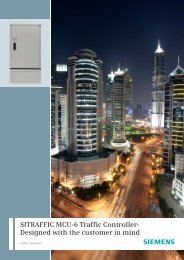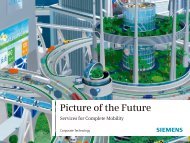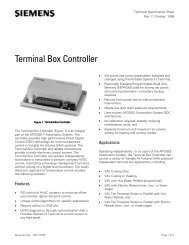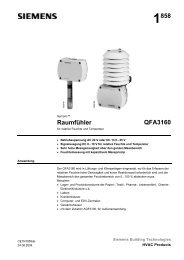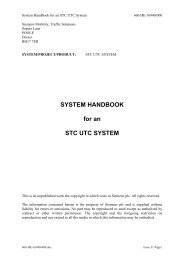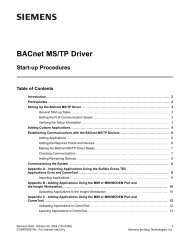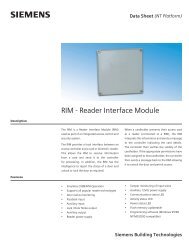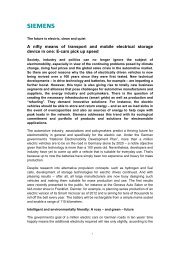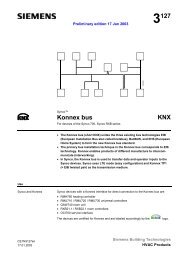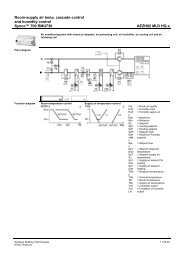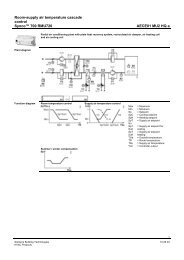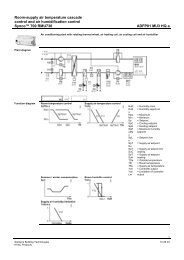Motor and Trailer Bogies for Heavy Metro Vehicles - Siemens
Motor and Trailer Bogies for Heavy Metro Vehicles - Siemens
Motor and Trailer Bogies for Heavy Metro Vehicles - Siemens
Create successful ePaper yourself
Turn your PDF publications into a flip-book with our unique Google optimized e-Paper software.
SF 5000 E JTDG <strong>and</strong> SF 5000 JLDG<br />
Jakobs-Type <strong>Motor</strong> <strong>and</strong> <strong>Trailer</strong> Bogie <strong>for</strong> EMU <strong>and</strong> DMU<br />
The bogie family SF 5000 was developed<br />
according to the requirements of<br />
modern Multiple Units <strong>for</strong> a service<br />
speed of up to 200 km/h.<br />
The bogie family consists of two axle<br />
bogies with a two-stage suspension<br />
system <strong>and</strong> an air spring as secondary<br />
suspension.<br />
Due to the modular design of the bogie<br />
family the following configurations are<br />
possible:<br />
Drive End- Jakobsbogie<br />
bogie<br />
Electric drive X X<br />
Diesel Single drive X<br />
Diesel Double drive X<br />
<strong>Trailer</strong> bogie X X<br />
The use of improved <strong>and</strong> optimized<br />
components of tried <strong>and</strong> tested bogies<br />
has led to the creation of a high<br />
per<strong>for</strong>mance bogie family which ensures<br />
high reliability, easy maintenance, low<br />
service costs, high flexibility <strong>and</strong><br />
excellent riding com<strong>for</strong>t.<br />
The bogies SF 5000 E JTDG <strong>and</strong> JLDG<br />
with an axle distance of 2800 mm are<br />
used in combination with the bogies<br />
SF 5000 E TDG <strong>and</strong> LDG <strong>for</strong> Express <strong>and</strong><br />
Commuter trains.<br />
A service proven link system is used as<br />
axle guidance. The primary springs are<br />
located above the wheelset bearings <strong>and</strong><br />
consist of steel coil springs <strong>and</strong> rubber<br />
elements <strong>for</strong> acoustical <strong>and</strong> electrical<br />
isolation.<br />
All longitudinal <strong>for</strong>ces between bogie<br />
<strong>and</strong> carbody are transmitted via traction<br />
rod. The secondary suspension system<br />
consists of air spring bags in<br />
combination with a pneumatic 2-point<br />
levelling valve system to compensate<br />
different loading conditions.<br />
In the case of motor bogies, the traction<br />
torque is transmitted from the motor to<br />
the wheels by a partially suspended<br />
helical toothed spur gear box <strong>and</strong> a<br />
flexible toothed coupling.<br />
The traction motor is directly mounted<br />
on the bogie frame by the use of rubber<br />
elements <strong>for</strong> acoustical isolation.<br />
Separation of the coupling enables the<br />
exchange of the wheelset with the gear<br />
unit without having to dismount the<br />
motor.<br />
Low-maintenance wheel mounted disk<br />
brakes are used <strong>for</strong> mechanical braking.<br />
Optionally the bogie can be equipped<br />
with an auxiliary air reservoir. This<br />
device is located between the air-spring<br />
<strong>and</strong> the carbody.<br />
49




